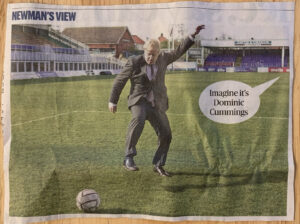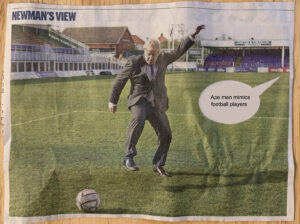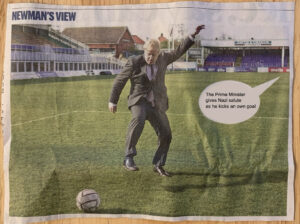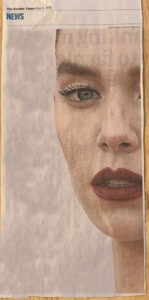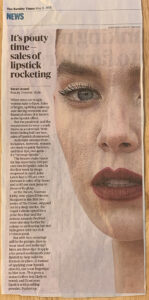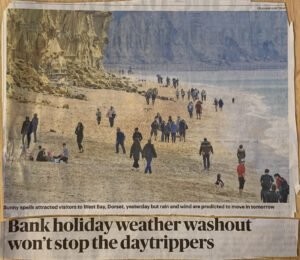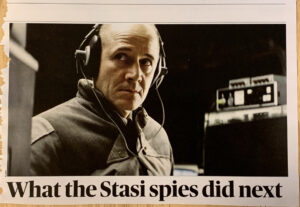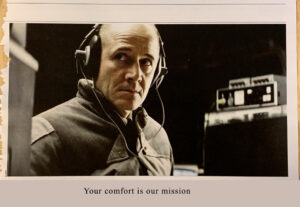Exercise 4: Alternative Interpretations
Over the space of a few weeks gather newspapers that you can cut up, preferably including a mixture of different political points of view. Have a look through and cut out some images without their captions. You could choose advertising images or news.
For each image, write three or four different captions that enable you to bend the image to different and conflicting points of view.
- What does this tell you about the power of text and image combinations? Now write some text that re-contextualises these images and opens them up to alternative interpretations. Write some notes in your learning log about this exercise.
Having looked at the images below, it is evident that the combinations of text and image are really important to our understanding of both. However, some images need more explanation that others. In relation to the stories, the most successful appear to be where the text adds extra meaning to the image (Relay).
- How might you use what you’ve learnt to add a new dimension to your own work?
In my own work, I can use text to ensure my intentions are clear or even to be ambiguous. It will be important to decide before presenting the work, which I want.
- understand what meanings the average viewer of the image might already be able to read
- does something that means thing to you mean something completely different to someone else. This reminds me of Assignment 4 in Context and Narrative where I wrote an essay about reading an image. This sparked a big debate about an element of the image that I read in a completely different way to him and he felt was the crux of the meaning, but which I felt had no particular meaning. On testing this theory with others, it transpired that men read this pose completely differently from women. Therefore, definitely test out your meaning on different viewers.
- add text that confirms or denies those assumptions. Make a deliberate choice
This is a repeat of an exercise completed in the Context and Narrative course:
For this exercise I have picked a number of images from the Sunday Times on 2nd May 2021. (I don’t usually buy newspapers or magazines, so this was a random choice whilst in a newsagents)
Boris
The first image of Boris Johnson (British Prime Minister) has the original caption printed in the newspaper. The text is a comment on the prime minister’s relationship with his former advisor, an attempt at humour. The second caption makes fun of the prime minister and suggests he doesn’t like football players and third caption re-contextualises the image to something much more negative and likens the prime minister to a Nazi leader. This has no bearing on my beliefs or thoughts, I am merely trying to show that an image that was printed as a light hearted political comment could potentially be given more negative connotations just by changing the caption.
I found this image quite difficult to read, at first glance you might think it is an advert, but it is in fact a story about how women buy more bright lipstick during times of crisis. Without the original text, I was drawn more to the model’s eyes and wouldn’t have been able to tell that the story would have been about her lipstick. Furthermore, for me there was no joy in this woman’s face which meant that the story I chose to re-contextualise this image was a more sombre one. I shared this image with some friends and family, without the words to see what they thought, as I struggled to find anything positive based on the image alone. One person thought it might be an advert for a new film,
My thoughts are that this image was used just to attract your attention and doesn’t really add to the story, other than it’s a pair of nicely painted lips but which don’t particularly reflect the story about bright lipstick.
The image itself tells us that there are a lot of people on the beach and we can see that they are wearing outdoor clothing rather than swimsuits. Most are walking rather than sitting and picnicking. Therefore, we already know from this image that the story isn’t going to be about the hot weather. In this instance the original text tell us how bad weather hasn’t stopped daytrippers going to the beach. My new captions are an attempt to add to what the image is already telling us, rather than describing the scene.
I chose this image because I really liked it as an image. The man in the image is using and ‘avertive gaze’ out of the image which implies something outside of the image is more interesting. The colours are desaturated and the lighting is low key, all giving the impression of something secret. The original caption adds the information that suggests he is a member of the cold war German security services. This connotation is only important if you know who the ‘Stasi’ are. This image plays on the eastern European stereotype of the everything being cold and dark. As per Barthes image, it probably wouldn’t mean anything to a German person or in this case perhaps anyone born after 1990!.
For this image I tried two different ideas with the text, one to add a story, and one to create a clothing advertisement. The later was found after an internet search for clothing slogans.
